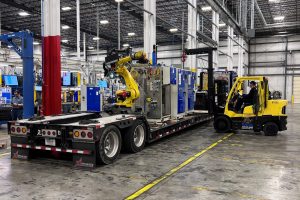 Transporting heavy industrial equipment is a complex process that requires meticulous planning and execution. Whether you need to move machinery for mining, power plants, construction, metalworking, manufacturing, or healthcare, it’s crucial to follow proper rigging and transportation procedures. In this comprehensive guide, we will explore the essential steps involved in hauling industrial and manufacturing machines safely and efficiently.
Transporting heavy industrial equipment is a complex process that requires meticulous planning and execution. Whether you need to move machinery for mining, power plants, construction, metalworking, manufacturing, or healthcare, it’s crucial to follow proper rigging and transportation procedures. In this comprehensive guide, we will explore the essential steps involved in hauling industrial and manufacturing machines safely and efficiently.
Industries That Require Rigging Services for Machinery
Various industries rely on heavy equipment that necessitates specialized moving services. Here are some sectors that commonly need rigging services:
- Mining: The mining industry heavily relies on transporting large and heavy equipment using rigging services.
- Power plants: Power plants house generators and other significant machinery that requires professional transportation services.
- Construction: Construction companies often have an extensive inventory of heavy equipment that needs to be transported between job sites.
- Metalworking: Large metalworking projects often require specialized transportation equipment.
- Manufacturing: Manufacturing plants frequently handle heavy containers for imports and exports, as well as delicate precision machinery.
- Healthcare: Healthcare facilities may require temperature-controlled heavy machine transport for delicate medical equipment.
Organizing and Packing Machinery for Transportation
The first step in the moving process is to organize and pack your equipment properly. This stage is critical for streamlining the entire moving process and minimizing any potential issues. Follow these steps for organizing and packing your machinery:
- Disassemble the machine: Begin by disassembling the machine, inspecting all its parts, and documenting the process. Take photos, record videos, or create a detailed list of all the components and how they fit together. This documentation will be useful during the reassembly process.
- Choose the appropriate packaging: Packaging techniques may vary depending on factors such as the nature of the cargo and the mode of transportation. Select packaging materials that offer the best protection at the most cost-effective price.
- Create a parts inventory: After packing, create a comprehensive inventory list that documents the location of each part. This list will help you keep track of all the components during the transportation process.
Selecting the Right Transportation Vehicle for Industrial Equipment
Choosing the appropriate transportation vehicle is crucial to ensure the safe and secure transport of your industrial equipment. Consider the dimensions and weight of your load when selecting the vehicle. Here are some common transportation methods for industrial equipment:
- Flatbed trailers: Flatbed trailers are suitable for smaller shipments. They can accommodate loads up to 8.5 feet tall, 8.5 feet wide, and weighing less than 48,000 pounds.
- Removable gooseneck (RGN) trailers: RGN trailers have a low sitting well and high weight capacity, making them ideal for oversize loads. These trailers can handle loads up to 11.5 feet tall, 8.5 feet wide, 29 feet in length, and weights exceeding 80,000 pounds.
- Step deck trailers: Step deck trailers are lower to the ground and offer more versatility compared to flatbed trailers. They can transport loads up to 10 feet tall, 8.5 feet wide, 48 feet long, and support weights of up to 48,000 pounds.
It’s essential to choose a vehicle that can safely and securely transport your specific load.
Compliance with State and Federal Regulations for Heavy Machine Transport
Complying with state and federal laws is crucial when transporting heavy machinery. Failure to adhere to these regulations can result in fines and compromise the safety of the load and roadways. Some key points to remember when it comes to compliance include:
- Wide load regulations: Large equipment, such as cranes and bulldozers, may be considered “wide loads” if they exceed height, width, length, and weight limits. These loads must follow specific regulations.
- Preparing the equipment for transport: Before moving, take additional steps to ensure the safety of the equipment and others on the road. Cover smokestacks with a tarp to prevent debris from entering, latch all doors securely, and unhook batteries to avoid power-related issues during transport.
Thoroughly research and understand the regulations that apply to your specific equipment and route to ensure a smooth and compliant transportation process.
Contact Us (859) 824-4177 for more information or to get a quote!
—
 About American Lighthouse Transportation
About American Lighthouse Transportation
American Lighthouse Transportation has been serving shippers with honesty and integrity throughout the United States, since 1998. You can depend on our experienced and knowledgeable management team, drivers, and support for all your shipping needs. We communicate effectively to make sure your shipment arrives safely, accurately, and on-time! You can count on us for personalized customer service, expert guidance, accurate anticipation of potential setbacks, and possible workarounds and solutions.